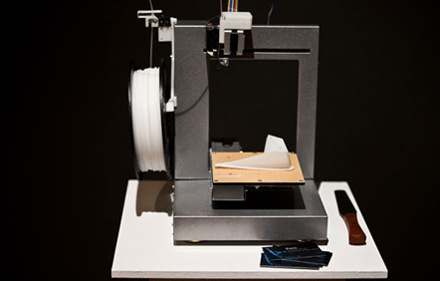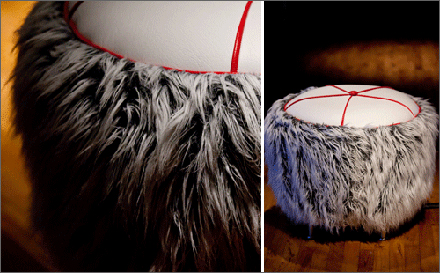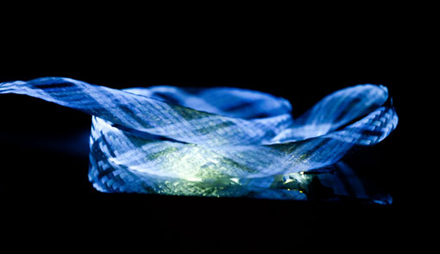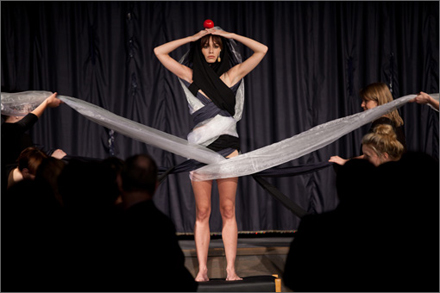News...
2011-12-12
Panel discussion – Technology,
Material thinking,
Craft - revisiting modernism?
View the panel discussion from the Ambience'11 conference »
Moderator: Johan Öberg
Participants:
Jenny Sabin
Mette Ramsgaard Thomsen
Alex Adraansens
Nancy de Freitas
Clemens Thornquist
2011-12-06
An experience among smart textiles and furniture
that wants to hang out
For the first time, the scientific conference Ambience’11 hosted an exhibition at the Museum of Textile History in Borås and where participating researchers exhibited smart textiles and other objects. The exhibited objects ranged from a pouf that breathes to masks changing color with body temperature.
The exhibition at the Museum of Textile History was a new approach and introduced a more experience-focused conference. The exhibited objects ranged from a pouf that breathes to masks changing color with body temperature.

iForm is an interactive iPhone sculpture. By downloading a GPS function to their phones, exhibition visitors were able to see the locations of the other people of the group.
- The software calculates the distance between each individual and the locations form clusters which in turn shapes into a plastic form, a small plastic sculpture, says James Charlton, one of the researchers behind iForm, New Zealand. James Charlton and his colleague Nico Refiti is interested in how we relate to the people in our immediate surroundings – in the spatial sense. Through a formula, a physical shape is created from the distance between people and becomes what James Charlton refers to as a “relational map”.

Light and Shadow Play is a project exploring different ways to use the sun to pronounce aesthetics through textiles in an urban environment. The sun’s path across the sky creates varying patterns in different places when it shines through the textile forms. Researcher: Barbara Jansen, the Swedish School of Textiles/Smart Textiles

Pouffy – the pouf that breathes was created by Twenty121. The idea behind the piece of furniture that breathes and moves is to keep its user company. If someone sits on it, it emits a “purring” sound to show its appreciation.

Woven light (left) may look like a lamp, but researcher Jan Carleklev considers it to be more about designing time, creating an experience for the audience. Tensed up (right) is a material which reacts to electric energy, both from people’s movements and sources of strong electricity. The material, which is conductive and resembles feathers, grow rigid when exposed to electricity. Researcher: Clemens Winkler.

rhythm exercise_13in1 is a braided object based on thirteen lengths of optic fibers which emits light through LED (Light Emitting Diode). The object is programmed to create moving light and conveys a feeling of 3D. Researcher: Barbara Jensen, the Swedish School of Textiles/Smart Textiles.

A formal dinner at Borås City Hall concluded the second day of the conference. The dinner guests were presented with an experience out of the ordinary in the performance Effect/Affect by Ulrik Martin Larsen, doctoral student in fashion design at the Swedish School of Textiles. The garments displayed during the performance were made by Delia Mihaela Dumitrescu, Mika Satomi, Lotta Lundstedt, Rickard Lindqvist, Stefanie Malmgren de Oliviera and Karin Landahl, all of whom are researchers at the Swedish School of Textiles.

2011-11-23
Ambience’11 opens
On November 27th the scientific conference Ambience’11 opens. For three whole days the interface between art, design, architecture and technology will be challenged. The conference is hosted by the University of Borås. New for this year’s conference is an exhibition held at the Museum of Textile History in Borås where participants exhibit physical objects.
– Ambience’11 is an exciting mix of scientists, artists, designers and innovators from all over the world coming together in Borås to present their projects, exchange experiences and inspire one another, says Agneta Nordlund Andersson, Organizing Committee Chair for the conference.
The curated exhibition at the Museum of Textiles History, where participants are given an opportunity to display physical objects, adds a new dimension to the scientific conference.
– The exhibition differs from a traditional conference. It is more of an experience, since it is possible for visitors to interact with many of the objects.
2011-11-01
Meet furniture that wants to hang out
Ambience’11 is a scientific conference that challenges the interface between art, design, architecture and technology. One unique feature of the conference is that scientists and artists are given the opportunity to display physical objects at an exhibition held at the Museum of Textile History in Borås.
– An exhibition is a natural part of presenting this kind of scientific results, there are works which require exhibition in their physical form, says Clemens Thornquist, professor at the Swedish School of Textiles and one of the organizers behind this year’s exhibition.
One of the exhibited objects is a sitting pouf that breathes. Another example is a chair that acts like an exotic bird – as you approach, it changes color and emits sounds. The possibilities are aplenty when technology and design meet, which will be visualized in the exciting exhibition at the Museum of Textile History.
FACTS: Ambience’11
The opening of the Ambience’11 conference is a vernissage of the exhibition on November 27th. The conference is based in four scientific fields: digital architecture, interactive design, new media arts and smart textiles.
The exhibition at the Museum of Textile History is open to the public.
KEY NOTE SPEAKERS:
Alex Adriaansens
Director - V2_ Institute for Unstable Media (Arts and Crafts industry)
Nancy de Freitas
Editor-in-Chief, Studies in Material Thinking Associate Professor, Auckland University of Technology
Jenny E. Sabin
Architectural designer, artist and educator, Jenny Sabin Studio
Times and places:
Conference: November 28-30
The Pulsen building, Nils Jakobssonsgatan 5, Borås
Exhibition: November 27-30
The Museum of Textile History, Druveforsvägen 8, Borås
Media contact:
Therese Rosenblad Eriksson Communication Officer at The Swedish School of Textiles
phone: +46 (0)33-435 45 23 cellphone: +46 (0)732-305960
e-mail: therese.rosenblad@hb.se
2011-03-09
Smart Textiles session
– Smart Textiles introduce a shift from passive functionality
Smart Textiles introduce a shift from passive functionality and static decoration to active behaviour and dynamic expressions. The notions of textile design materials and technology will change and along with them basic design aesthetics will also have to change; these new textiles will introduce a new type of expressiveness. Smart Textiles will transform the craft and profession of textile design. It is a new type of materials that through computational technology makes the material basis of the design process somewhat more abstract; dynamic patterns, reaction behaviours etc. which, just like music, only “exist” in performance, through use, in time. This will change the way we work and it will require new basic skills and new types of artistic practices.
2011-02-30
New Media Art session
– New forms of art emerges along with the development
New forms of art emerges along with the development of new materials and new technology; cyber art, internet art, video art, interactive art, computer graphics etc. New Media Art is artistic work at the crossroads where art and modern technology meet. It is a matter of new ways of displaying and communicating artistic work, of forming new artistic arenas using modern technology. It is a matter of critical reflections on the development of technology, of discussing issues of modern technology and its role in society through artistic work. It is a matter of new materials and techniques for artistic work, of mastering modern technology as means for artistic expression.
2011-02-22
Interaction Design session
– As the computer itself fades into the background
As the computer itself fades into the background, computational technology reappears as a new expressive design material. We build things in a new material; we build computational things. The defining characteristic of the material is simply that its behaviour is dictated by the execution of given programs. The computational material is very much alike that of music: a time-material that shows itself only when we activate it. What is essential in interaction design today is design focused on application combined with a view of computational technology as a new expressive design material.
2011-02-10
Digital architecture session
– towards a computational material practice
Architecture is engaged in a radical rethinking of its material practice. The evolution of digital media has prompted new techniques of fabrication but also new understandings in the organisation of material through its properties and potential for assemblage. Advancements in material science and more complex models of material simulation as well as the interfaces between design and fabrication are fundamentally changing the way we conceive and design architecture.
2011-01-31
Post conference publication
All accepted submissions will be published in the printed conference proceedings. For post conference publication there will be two alternatives:
- - Conference proceedings and the exhibition catalogue will be published electronically in Borås University Digital Archive BADA (Borås Academic Digital Archive).
- A limited, and focused collection of papers will be published in a special issue of Studies in Material Thinking www.materialthinking.org - only abstracts of these papers will be included in the on line proceedings published in BADA.
The special Ambience11 issue of Studies in Material Thinking will focus on material thinking in the expressional crossroads where art, design and technology meet; the new ways of thinking about and through materials in the inter-relationship between art and design practices.
With the help of the program committee of Ambience11 editor in chief Nancy de Freitas and conference chair Lars Hallnäs will make a selection of papers submitted to Ambience11 and invite authors to publish their papers in the special issue of Studies in Material Thinking. Selection will be based on final full papers and authors will have the possibility to revise papers prior to publication in the journal.
Important dates:
- The invitation to publish a paper in the special issue will be communicated to authors by November 15, 2011.
- The final, revised version of the paper should be submitted to Studies in Material Thinking no later than January 15, 2012. The new volume is expected to be on-line February/March, 2012.
- Conference proceedings and the exhibition catalogue will be published on-line in BADA February 2012.



